Today we’ll start with the various types of Research Methods. This is a very very important topic I would say, for the NET examination. Before we start understanding why do ye need various types of research methods or there are different types of research methods. Let’s understand, why there is a need for different research methods?

Let’s see at the infographic, in case 1: where there was a Tsunami, and after the Tsunami I’m studying the effect of it on the people in that area.
In Case 2 I have a kind of new drug that has been related in the market and I’m trying to understand the impact of the drug on the age group 5-15 years.
These two are different cases and the methodology or the approach that I would use for case 1 and case 2 would be entirely different. Since in case 1 there is something that has already happen and we are studying the impact after the event is over, we would be using a kind of ex post facto research. We’ll discuss further what it means?
In case 2 we are trying to do an experiment of a new drug that has been released on in the age group of 5 to 15 years. Enhance we would be using a kind of experimental design.
The approach or the methodology that I am using to study case 1 and case 2 is entirely different. It is important to understand the various research methods are which a method should be applied where it is an integral part of it. Most simple questions when they are asked you have either a case study or a scenario given or an event given and then you are asked “what kind of research would be applied on this” in a case like this. In all those cases you need to be very clear about the concepts of the various types of research.
The Basic Framework: Type of Research Methods
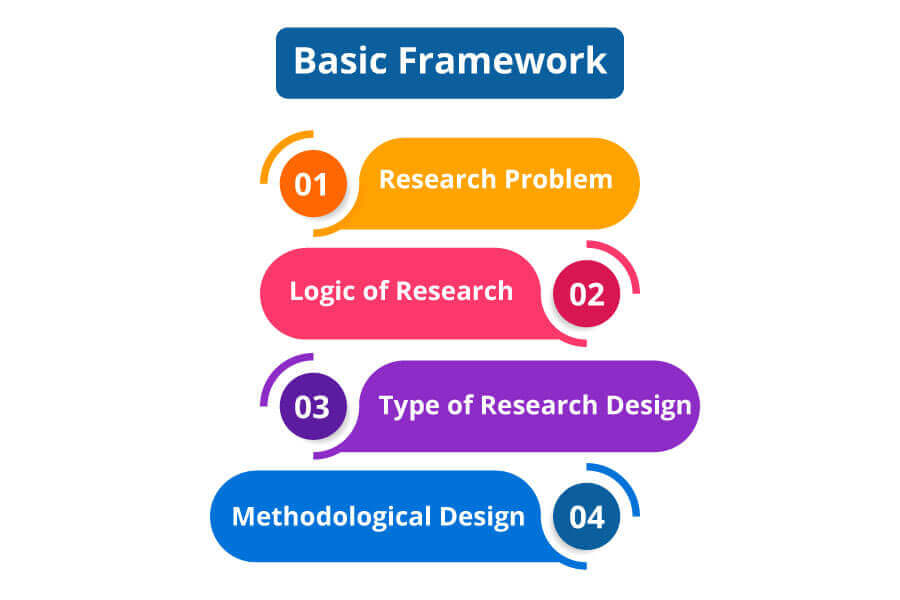
Before we move further to the individual types of research, let’s first understand the basic framework. Here we would be trying to understand is we have a kind of research problem. We have the logic of the research. Why we are using certain research and then we use a type of research methods and this what we’ll be focusing on the post. Out entire focus would be exclusively on the types of research design. And finally, based on the types of research design that you are using, you design a methodology.
For example, if all my research is quantitative, I use more of the statistical analysis. The methodology that would be used would be determined by the types of research devise that I am using.
Various research Methods:

Basic research:
It is also known as pure research or fundamental research. Basic research tries to devise or move forward to understand new knowledge. What is the importance under the basic research is we are trying to formulate a new theory? It’s the advancement of the exiting theory or a step towards formulating a new theory. That’s what we deal with the basic research or pure research or fundamental research that we say. This kind of research is usually done in technical language. A person in a specific subject matter who is an expert in a subject matter can very well comprehend. But a common man cannot understand it. For example, if I do basic research and say physics a person from a background a physics would be well able to comprehend. But a person from a background of humanities may or might not be able to comprehend that.
Applied research:
Applied research aims to solve specific problems. So, that’s the key here. Under fundamental research, we are trying to gain new knowledge. So, we are trying to explore all the areas why, what, how, where. All those would come under fundamental research. But when it comes to applied research we are nearly focusing on the specific problem. When we are focusing on one single problem, our aim is to get an immediate solution from the problem. The immediate solution to the problem is another aim and since applied research is aimed at a specific problem it is usually in common man’s language that everyone from all backgrounds can understand.
Fixed Versus Flexible:
The next types of research are fixed V/S flexible.
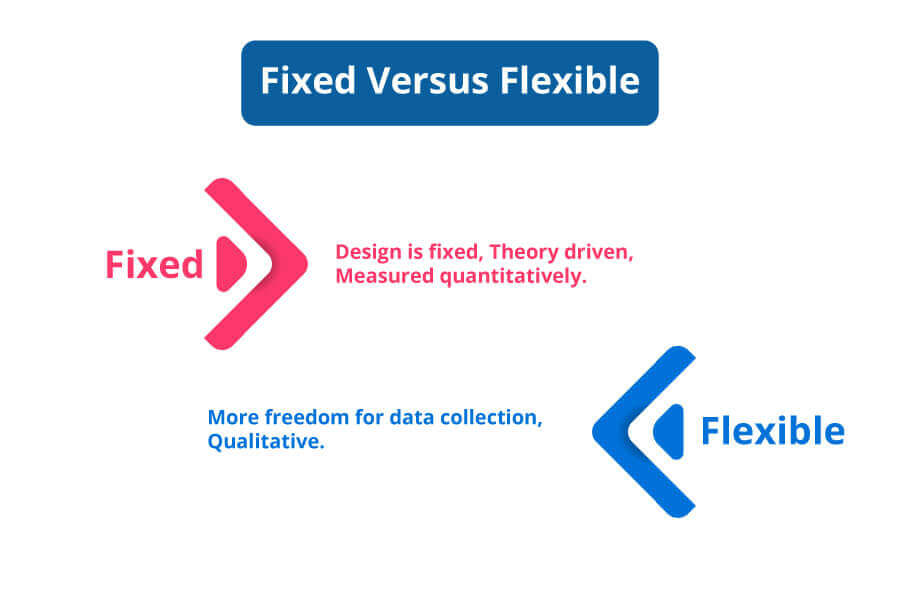
Fixed research:
Fixed research is research when you have a kind of design that is fixed. It is driven by theory and it is measured quantitatively. Since you have fixed parameters the only way you give major is through numbers. It’s a quantitative measurement.
Flexible research:
Under flexible research, you have more freedom of data collection. Can collecting data through interviews, through survey, through telephonic interviews or telephonic questions. All those who come under flexible research where I am having more than one dimension of research. Finally, you have flexible research is qualitative in nature.
The Quantitative Versus Qualitative:

Quantitative research:
The quantitative works with data collection or numbers. What we are trying to do here is understand the various collection methods and analysis or the data. This data is mainly statically analyzed and the data that is obtained is main in the form of questions, stickiest or surveys. This quantitative method assumes that word is stable and what we can do is we can major or quantify the data.
Qualitative Research:
The qualitative data, on the other hand, says that the world is unstable. It’s not coherent. Every idea of one person differs from the idea of other people. It’s not uniformed and what we need to major is through non-numeric ways like observation, interview. All these behavior techniques would come under qualitative assessments.
Qualitative assessments are more narrative and field focus. The basic idea here is the approach is inductive. However, under quantitative the approach is deductive or logical.
Let’s quickly recap what we had discussed about the deductive and the inductive approaches. Now inductive I’ll remind again the call it is ISG. It is the best way to remember. We move from specific to journal and inductive approach and vice versa under the deductive approach.
This is the cycle if you move from theory to data and finally to the theory you would have a kind of deductive approach. Under inductive, you move from specific data and come up with a theory. So, under the inductive approach we also call it an ethnographic inductive logic, what we do is, we read, we gain experience, we describe the implications and explain it.
However, under hypothetic deductive logic, what we do is we read, we develop the idea, we gather evidence to test the findings and finally discuss the findings.
Experimental Versus Non-Experimental:
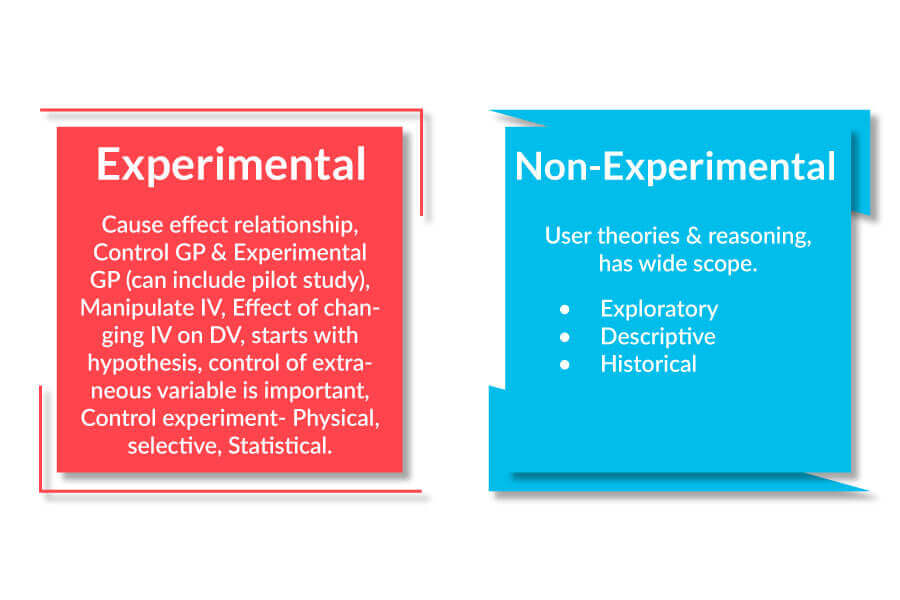
Experimental:
As I said there is a kind of very simple way to explant it. There are two groups. i) A control group, ii) An experimental group. For the control group, I’m not manipulating the independent variable. For the experimental group, I’m manipulating the independent variable.
We will be discussing variables more in a separate topic. Just for now we talk about the difference between the independent variable and dependent variable. Let’s say age varies with IQ.
What is warring here, is age. So, age becomes the dependent variable. However, age is dependent on what parameter? It is dependent on IQ. So, IQ becomes the independent variable.
Under experimental settings what we are trying to do is we are trying to manipulate the independent variable. And we are trying to see the effect of change of the independent variable on the dependent variable. This is run under a controlled setting.
Now, what kind of controls can you use under an experiment? These can be physical controls. So, I am limiting the number of people who are sitting in the room. That’s the kind of physical control. I am checking out the ambiance. So that the person who is working on the questionnaires is not distracted. It can be selective, so I am picking up a specific age group. That is another kind of control. Or, it would be statistical while calculating. All this we discuss under the experimental study. And experimental studies primarily based on causes and effect relationship.
Non-experimental research:
Non-experimental research studies use theory and reasoning and they have a much wide scope. The common types of non-experimental research that we discuss abut are exploratory, descriptive and historical. Let’s understand this one by one.
Exploratory Vs. Confirmatory Research
The first one is the exploratory Vs. the confirmatory approach.
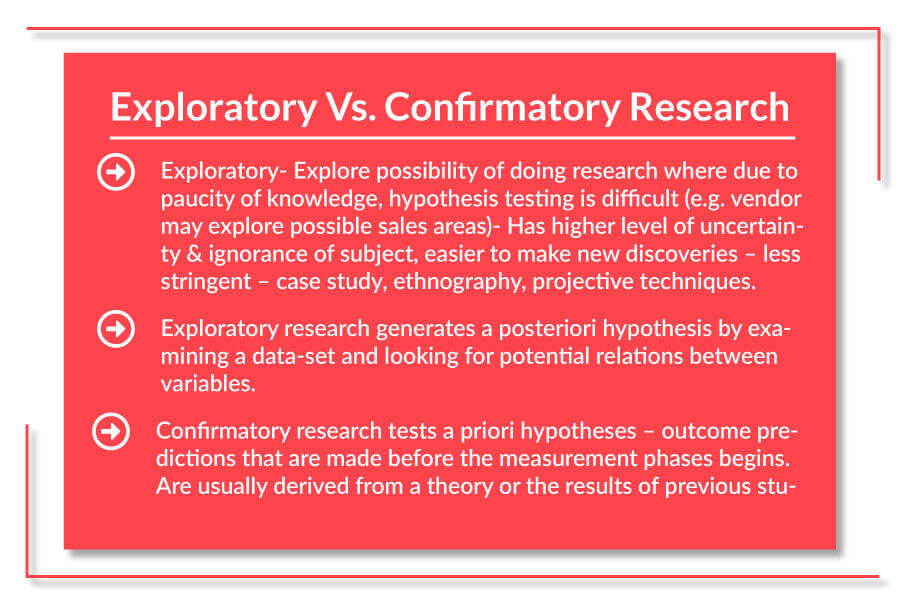
Confirmatory approach:
The confirmatory approach is a kind of A priory hypothesis, they talk about the outcome predictions. That is made before the measurement phase begins. I have a kind of measurement that I am trying to do and before that, I have a kind of outcome prediction in mind. If this would be event these would be the outcome. So, That’s the kind of confirmatory research. And these are used to derive from theory or the result of a previous study that has been already done.
However, exploratory is much wider you are trying to explore new possibilities, new areas where there is the existing polity of knowledge. Let’s say there are many people who are doing research on, how to establish or how to prepare homes at mars for example. So, that’s the kind of exploratory study. What you are doing is there is little knowledge about whether these are life is possible at mars or not.
So, What the study would involve is a kind of testing of hypotheses becomes very difficult here. It’s a kind of A posteriori hypotheses that we try to do. Where are examining the dataset and looking at the potential relations that could be established between the variables? That is what is exploratory. Exploratory research has a high degree of uncertainty. I do not know whether my research would be successful or not and you are ignoring the subjects you are not bothering about the subjects. You are ignoring the subject and you are only focusing on generating some new discoveries. Which can be by means of projective techniques or by means of ethnography. Where you are discussing different cultures.
Explanatory or Casual Research:
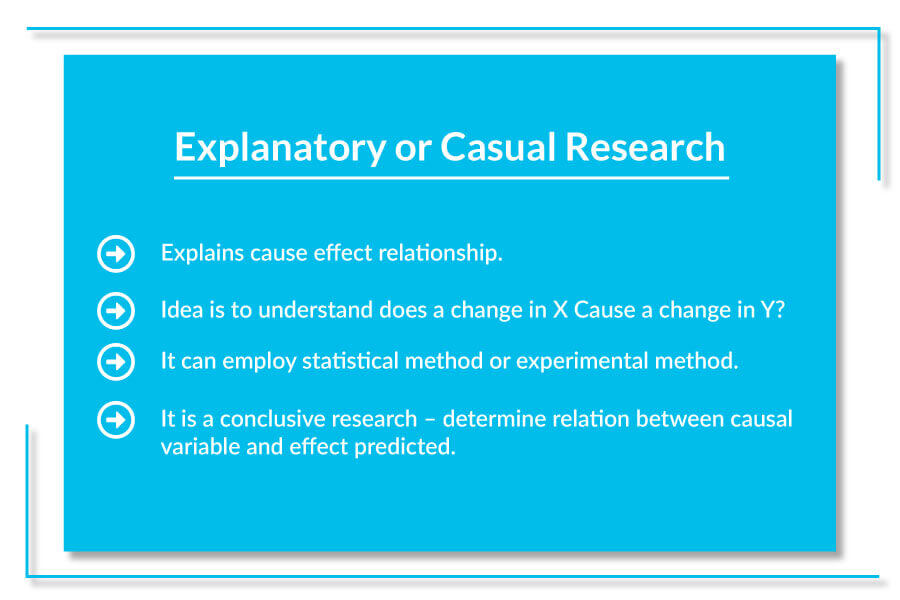
The next is explanatory. There is a difference between exploratory and explanatory. These are totally two different types of research methods. Explanatory is also knows as casual research. And it talks about the cause-effect relationship similar to an experiment. But we are not exactly doing an experiment here. It would not be a kind of laboratory experiment or filed experiment that we age doing. But we are trying to understand the cause-effect relationship.
Let’s say the impacts of X on Y. so, the impact of rainfall on agriculture, for example, would be an explanatory study. We can say if the rainfall is less the agriculture would be less. That’s a kind of cause-effect relationship. Its employee’s statistical data. It can sometimes employ experimental methods. But it is not exactly the experimental method. These two are different we have an experimental method. That is different from the explanatory method.
However, the explanatory method can employ the experimental method as one of its way to do the research. Explanatory research is much more conclusive. I have strong results when I come up with a finding of explanatory research and this conclusive research has to establish a good relationship between the cause variable and the effect that has been predicted. So, this was the explanatory or casual research and this is very different from the exploratory research where you are trying to explore the new possibilities.
Descriptive Research:

The next is descriptive research. Descriptive research is interesting. The only thing that you need to know here is you are not dealing with how? The only thing that you are dealing with is what and why. You are not into how things are form, how things work. All that parameter of how where you have an element of functioning is totally ignored by the descriptive research. What are the benefits of multimedia text as compared to print textbooks?
Let’s say if you have an Exam page book you would see the YouTube links embedded within the books. That would be a kind of multimedia textbook. What would be the advantage of that overprint media you can say ok I am reading the topic on research methods and I have a link for those types of video. So, that’s well and fine I can have the theory as well as the video. It would be a kind of audio-visual way of study and that would be a kind of multimedia textbook.
The next is the descriptive method more structured as compared to exploratory method. Because under exploratory you are trying to define new boundaries. This is further divided either into static or dynamic. Static deals with one single phenomenon. For example, let’s say public opinion. However, the dynamic is based on two methods cross-sectional and longitudinal.
Longitudinal means how it varies over time. Let’s say 10 years back and 10 years from now. How the things would be related to a kind of longitudinal study. The cross-sectional study would be over the same time period. So, you have the time period that remains constant. But you are trying to understand the different aspects of the study at the same time. That is the cross-sectional study.
Descriptive research can further be done in the three heads. You have either the survey studies where you are trying to access the characteristics of the whole population. Interrelationship studies where you are trying to see the interrelationship among data. It can be in the form of case studies, causal-comparative or correlational study will understand the casual comparative and correlational studies further.
Then you have the developmental study, which talks about changes with time. Pre-dominantly a kind of longitudinal study. This would help you understand the growth, trend and model development.
Historical Research:
The next is historical research. As a name suggested it deals with past events. Since it is dealing with past events it is more qualitative. You are not exactly working on data and numbers. It’s a kind of qualitative study. What Harappans use to do, how was there lifestyle and how is our lifestyle. That’s a kind of historical research we are doing. How lifestyle or settlement patterns have evolved over the years.
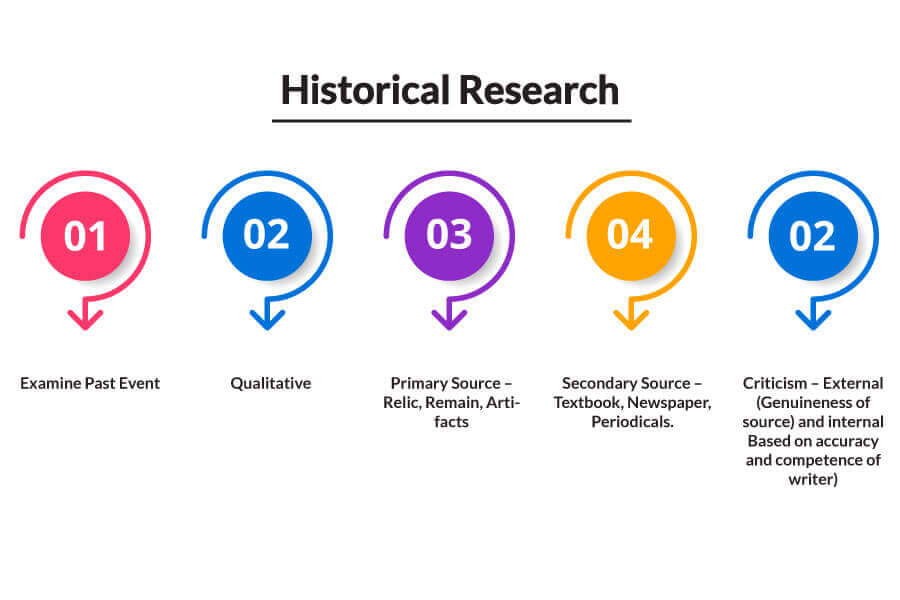
Historical research can be done or the data for it could be collected in two ways. Primary source and secondary source. Primary source as the name of the direct source. Any artifacts or any remains or any relets that you find from the Ancient time would be the primary source. The secondary source would include textbooks, newspapers, periodicals, and generals.
The criticism for historical research can again be divided into two. External criticism and internal criticism. The external criticism would say the source that I’m using is not genuine. Let’s say I’m using some relic or I’m using some artifact but that is not a genuine source. It’s not as old as a Harappan civilization. So, that’s a kind of external criticism.
The internal criticism talks about the bases for the accuracy and competence of a writer. The person who is writing the text who is writing in the periodical or the journal is not a competent writer and there are flows with the accuracy of the data or the accuracy of the information.
Ex-post Facto Ro Casual Comparative Research:
As we said at the top of the post, we will be discussing the casual comparative and the co-relational study and other inter-relational studies that are here.
Casual comparative is also known as ex-post-facto. The simplest way to understand ex-post-facto is it’s after the face has happened. So, it’s ex-post-facto. Once the fact has happened you are studying it and that is what is ex-post facto. Most of the students get stuck up and what is ex-post facto the name only appears difficult to most of them. The important thing to note here is it implies or it uses quasi-experimental designs. The quasi-experimental design is a design where participants are not randomly assigned. You have two groups that have different independent variables and you are comparing them on a dependent variable.
You are comparing two different groups with different independent variables on a common dependent variable. The independent variable becomes the cause here which is prior to study and affects the dependent variable that’s the effect. As I said tsunami-hit areas and studying the people of the tsunami-hit area. After the tsunami has accrued would be kind of ex-post-facto research. Under this study what is important is, the researcher cannot alter. Let’s say I’m doing a study where we talk about the importance of overweight on a person’s behavior.
To study that I cannot ethically make a person overweight. That’s one of the major limitations I would say of this ex-post facto research or what it implies is studied what the researcher cannot alter. This is something I cannot alter, I cannot make a person overweight, just because I want to study the overweight person’s behavior. This is something that is very important to understand you cannot alter the study under ex-post facto.
Correlational Research:
The next is correlation research. As the name suggests what you are trying to do is, you are trying to apply correlation here. You are trying to studying the relationship between two variables. When you are studying the relationship between two variables. It’s kind of quantitative studies that you are using and you are moving from the minus one zero to plus one that’s the range of co-relation. That means a strong positive co-relation is plus one, minus one is strong negative co-relation and zero stands for no co-relation. Let’s say age varies with IQ. If I say the value is plus one that means age varies with IQ is strongly co-related and as you increase in the age the IQ increases.
If I say they are not co-related that means they are independent and all the parameters would be randomly distributed. I do not know what is the effect of age on IQ. When I say age variable with IQ I would say when it is negative one it means it declining. As you increase an age as you grow in age the IQ would decline.
These are the three cases that we try to understand under co-relational research.
Evaluation Research:
The next is evaluation research. It deters minds from the impact of social intervention. The impact of the program of any specific social problem would be studying under evaluation research. It implies four different methods. The first is the scientific experimental method that has good accuracy and objectivity. The next is management oriental strategy. That implies either the PERT approach or a CPM approach. The CPM approach talks about the critical path that should be followed and finally the program evaluation and review.
These are the two methods that work under the management technique under the qualitative anthropological model we talk about the importance of observing. And finally under participant oriented we talk about whether the approach is a client-centered or stakeholder approach. So, whether it is focused on a client or it is focused on the stakeholder. These are the various ways under which we try to understand evaluation research. The most important idea to know here is evaluation research understands the impact of social intervention. Any phenomena that accrue its impact on social sittings or how it deals with the social problem is important.
Under evaluation, we had two different types either a formative evaluation or a summative evaluation.
Summative evaluation accrues towards the end. So, it’s the final outcome you are trying to examine the effect or the final outcome. It’s similar to the FA and the SA exam that you had used to have inboards. So, It’s the formative assessment and the summative assessment. The summative evaluation you have towards the end. What is important as you studying the outcome. The impact is much broader than the outcome. That’s the second parameter under summative evaluation.
The next is a secondary analysis and meta-analysis. In the secondary analysis, you re-examine the data to address new questions. Whatever new question comes up you try to understand those and you try to re-examine the data based on the new questions answer the new question that comes up. Meta-analysis is integrating the various outcomes from multiple studies. Let’s say the outcome from four different studies and integrated under one hand and that would be a meta-analysis. When we talk about formative our aim is to improve the object being evaluated. So, that it performs well when it comes to summative assessments. We can say that in simple terms.
Formative is a kind of midterm assessment. What we are trying to do is we are trying to help students. We are trying to help the participant understand how you could perform better next time. It involves four strategies.
You have the need for assessment. When you are trying to understand who needs? What and how great or how important that need is?
The next is the evaluative assessment. You are trying to see whether that evaluation is feasible for that reason or not. We are trying to do a structured conceptualization. Seeing that the participant has a conceptional building on that idea. He is working and finally, it’s implementation should be transparent. It should not be affected by other parameters and that should be no buyers and finally as we said this is the process that aims to improve the object who is being evaluated. Ultimately it’s a kind of determined for the object.
Diagnostic Research:
The next research is diagnostic research. Under diagnostic research, we try to find the cause. It’s when you have things that have already happened. Very good e.g. would be a case of medical. You have a mosquito bite and the person who already has malaria. Now once you know the person is diagnosed that he has malaria, we are doing the diagnostic research. We are trying to understand the cause and emerge from the problem by diagnosis and providing adequate medicine.
Prognostic Research:
Under prognostic research what you do is that reason is prone to malaria because the region is bleeding from numerous mosquitos. What we need to rule out is rule out the breeding ground of mosquito. That is a kind of prognostic research. We are trying to find a relationship between the outcome that is malaria and the predictor here which is the breeding areas. So, we are trying to find out the relation between two and then you take the necessary force of action to prevent the outcome. So, prognostic research focuses on early detection and care both of these are commonly used in medical sciences.
Action Research:
The next important is action research which was asked in January to a thousand and seventeen. Since it was asked in January to thousand and seventeen it is being important for the next upcoming examinations. So, we discuss This in detail. Action research as we discuss evaluative research or other evaluation research, action research is different. It’s a kind of more inclined towards applied research. Because we are trying to solve an immediate problem, that’s the first key element. We are trying to solve the immediate problem. You have the actors who are working to solve the problem. The main people who are working to solve the problems are known as actors and since you have actors who are working around you call this as action research.
This is led by a team and that would have a practical approach or a participatory approach. I can involve all the members of the team and work around as a participatory approach. Or, I can have a much practical outlook and work on the individual elements. That is how you work around with action research. It might include observation, interview, field note, survey or questionnaire. This action research can be further classified into three hands. The individual research where you are studying just one person.
You have collaborative research, where you have two or more groups of people. Or, you have a kind of school-wide or region-wide action research. Where you are involving the entire group that is present in that region. Be at school, be at collage or be at any reason specific problem. What you are trying to address. You have a kind of entire system that would work together. These are the basic three ways under which you understand action research.
Types of research problem address:
We have discussed the various types of research methods. Now the most important thing here is what kind of research should be applied where? Let’s say exploratory research.
What we are trying to do was explore new ideas, explore the possibilities. and what kind of questions they are asked? And what is the case & what are the key factors? That’s the basic thing you must keep in mind.
Descriptive questions focus on how many what is the incidence of X or how are the relationship between X and Y. How many is fine? But we are not talking about how. So be very careful. Previously we said how is not a part of descriptive research. How things function would not be a part. But how many they count the basic what and why would be a part of descriptive research. How many can be a part of descriptive research but how things work? How do things function? It would be not a part of descriptive research.
Casual questions would ask why what are the causes for X or Y? Then you have evaluated research. That would understand what was the outcome for X or has been more successful than Y. All those questions like these would be addressed under evaluative research. Under predictive we are trying to see the impact of one on the other. So, It’s the effect of Y on X. That’s a kind of predictive research.
Finally under historical research what let to happening of Y or were the events that led up to Y. What cause Y? All these are a kind of study when you are trying to understand past elements. So, all these would be falling under the historical research. This was just to give you an idea of what we had discussed until now. That you have a kind of mental picture while you need to study the types of research and what is kind of research.
One important thing that we missed during discussing. The research design and research methodology are two different areas. Under research design, our focuses to work on the end goal. I have to reach the final step by hook or crook. That’s what is the research design.
Under research methodology, my focus is to work on the process of how to reach my goal. So, when you are focused to reach the end product, the final step you either apply historical study or exploratory study. You have the point of departure that is driven by the research problem or the research question. And it focuses on the logic of the research.
However, when you are trying to reach the process, you would do either survey. Do document analysis. You analyze by means of secondary data. Primary data. All those would go under the research methodology. This is driven by the task that you have in hands. It mainly the data collection I would say. When it comes to quantitative research, when it comes to qualitative research, it could be by means of observation or by means of interviews.
The basic idea under research methodology is to focus on individual steps and not on logic. Where is the result design the total aim to focus on the logic and move forward to the end product? With this, we covered the types of research and research methods. We would be working around with more topics related to research methodology like sampling, variable, hypotheses in the other of our posts.




